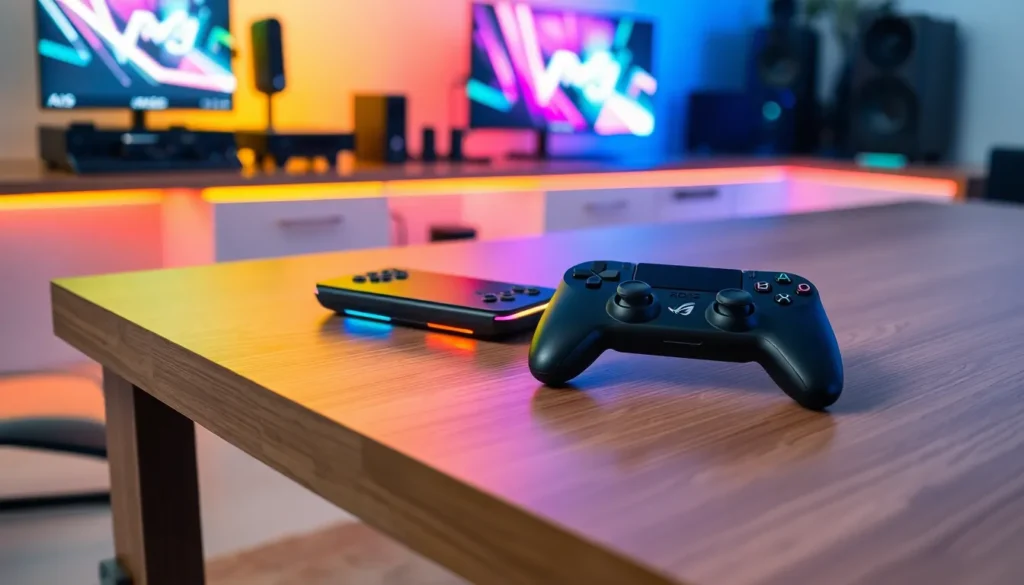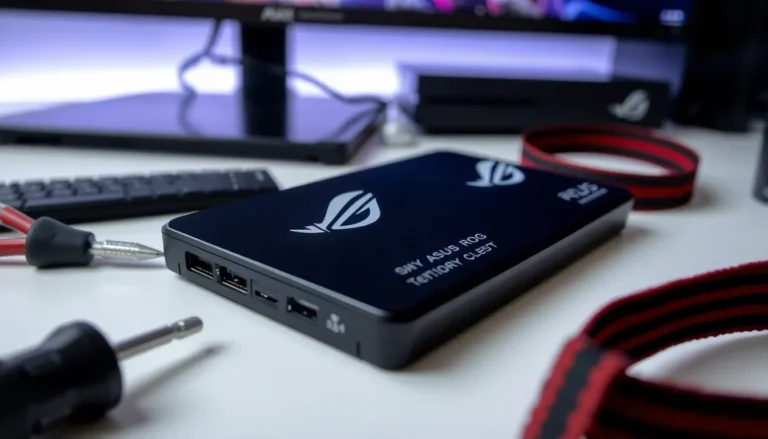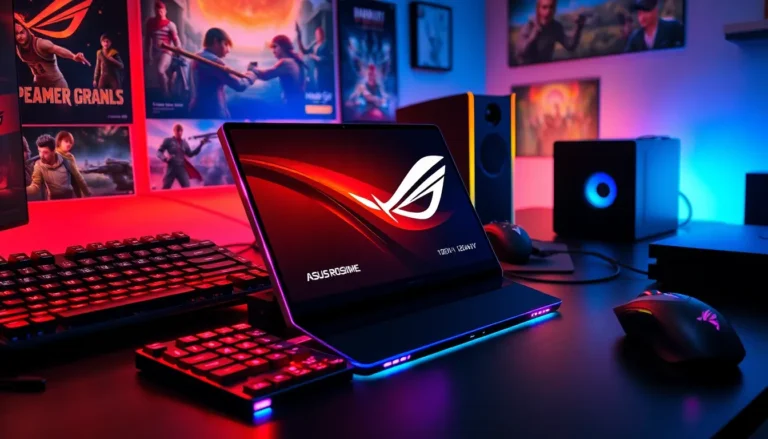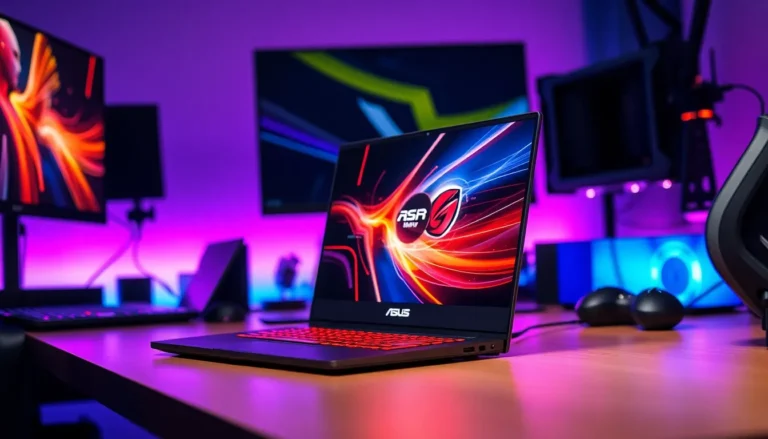In the ever-evolving world of gaming, choosing the right handheld can feel like picking a favorite child—impossible! Enter the ASUS ROG Ally and the Legion Go, two titans ready to battle for your gaming affection. With sleek designs and jaw-dropping specs, these devices promise to deliver an experience that’ll make you question why you ever played on anything else.
But which one deserves a spot in your gaming arsenal? Is it the ROG Ally with its flashy features and performance prowess, or the Legion Go that boasts a unique approach to portable gaming? This showdown isn’t just about numbers; it’s about which device will keep you glued to your screen and away from responsibilities—if only for a few more hours! Buckle up as we dive into the ultimate clash of handheld gaming giants.
Table of Contents
ToggleOverview of Asus Rog Ally and Legion Go
The ASUS ROG Ally and Legion Go represent cutting-edge innovation in handheld gaming. Both devices aim to deliver immersive gaming experiences for players.
Key Features of Asus Rog Ally
ASUS ROG Ally boasts a high-performance AMD Ryzen Z1 Extreme processor, enhancing gameplay fluidity and speed. Its 7-inch FHD display showcases vibrant visuals, providing sharp image quality and fast refresh rates. With a 512GB SSD, ample storage accommodates various game libraries. Players enjoy expanded connectivity options, including USB-C ports and Bluetooth support, facilitating seamless compatibility with accessories. Additionally, a customizable RGB lighting system enhances the device’s aesthetic appeal, aligning with gamer preferences.
Key Features of Legion Go
Lenovo’s Legion Go features an impressive AMD Ryzen 7 processor, offering powerful performance for demanding games. Its 7-inch QHD display guarantees dynamic colors and sharpness, enhancing visual engagement. Storage capacity reaches 1TB, allowing gamers to download multiple titles without compromise. A unique controller design emphasizes ergonomics, ensuring comfort during long gaming sessions. Adaptive cooling technology keeps the device operating efficiently, mitigating overheating concerns. Furthermore, integrated streaming options enhance versatility, catering to a broader audience.
Performance Comparison

Performance is crucial in determining the better handheld gaming device. ASUS ROG Ally and Legion Go showcase distinct strengths in gaming performance and battery life, contributing uniquely to the gaming experience.
Gaming Performance
Gaming performance significantly influences user experience. ASUS ROG Ally showcases an AMD Ryzen Z1 Extreme processor, enabling seamless gameplay at high settings on demanding titles. The 7-inch FHD display provides vibrant visuals, enhancing immersion. Legion Go, powered by an AMD Ryzen 7 processor, offers compelling graphics and smooth frame rates. Its 7-inch QHD display also elevates visual fidelity, with detailed graphics. Both devices cater to gamers, ensuring a competitive experience, yet the ROG Ally excels in responsiveness, while the Legion Go focuses on rich detail.
Battery Life
Battery life affects how long gaming sessions last. ASUS ROG Ally features a battery optimized for up to 6 hours, depending on usage and settings. The device supports gameplay without frequent recharges. Legion Go, on the other hand, boasts a larger battery, providing up to 8 hours of continuous use. This extra endurance caters to on-the-go gamers, enabling longer sessions without interruptions. Each device presents pros and cons in battery performance, with the Legion Go standing out in longevity, while ROG Ally balances performance with battery efficiency.
Design and Build Quality
Both the ASUS ROG Ally and the Legion Go showcase impressive design elements that appeal to gamers.
Size and Weight
The ASUS ROG Ally measures 11.2 x 4.8 x 1 inches and weighs approximately 1.5 pounds. This lightweight build promotes portability, making it easy to carry during travel. The Legion Go, on the other hand, features a slightly larger profile at 11.6 x 5 x 1.1 inches and weighs around 1.7 pounds. While it’s marginally heavier, gamers may find the additional mass contributes to a solid feel in hand. Comparatively, both devices are designed to offer comfortable gaming experiences during extended sessions, but preferences may vary based on personal taste in size and heft.
Durability
Durability stands as a key factor in the design of both devices. The ASUS ROG Ally incorporates a robust plastic shell that withstands everyday wear and tear. Reinforced corners enhance its resilience against drops or bumps. In contrast, the Legion Go utilizes a metallic chassis, offering a premium feel along with increased shock resistance. While both devices boast impressive durability, the metallic finish of the Legion Go may offer an additional layer of protection. Each device aims to endure the rigors of active gameplay while maintaining aesthetic appeal.
Pricing and Availability
Pricing plays a crucial role in choosing between the ASUS ROG Ally and the Legion Go. Each device presents various pricing points to match different budgets.
Cost Comparison
The ASUS ROG Ally retails starting around $599, offering a competitive price for its specifications. In contrast, the Legion Go begins at about $699, reflecting its premium features and larger storage. Both devices justify their costs through performance, display quality, and design innovations. Gamers looking for high performance with lower investment may lean towards the ROG Ally. Those seeking advanced features and higher storage capacity might find the Legion Go a more appealing option.
Where to Buy
Availability of both devices is widespread across multiple platforms. Retailers such as Amazon, Best Buy, and Newegg list both the ASUS ROG Ally and Legion Go for online purchases. Local electronics stores often stock these devices, allowing customers to experience them firsthand. Additionally, checking official brand websites can yield exclusive deals and bundle offers. Regular promotions and discounts may also appear during holidays or special sales events, providing opportunities to save.
Conclusion
Choosing between the ASUS ROG Ally and the Legion Go ultimately depends on individual gaming preferences. The ROG Ally shines with its responsiveness and compact design, making it ideal for gamers who prioritize portability and performance. On the other hand, the Legion Go offers a larger display and enhanced battery life, catering to those who appreciate immersive visuals and extended gameplay sessions.
Both devices stand out in terms of build quality and innovative features, ensuring they can withstand the demands of active gaming. Whether one leans towards the ROG Ally’s sleek design or the Legion Go’s ergonomic advantages, each device promises to elevate the gaming experience. Gamers are encouraged to consider their unique needs and budget when making a choice, as both handhelds deliver exceptional value in the competitive gaming landscape.










